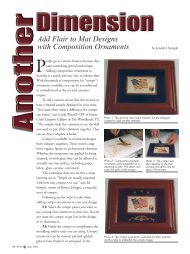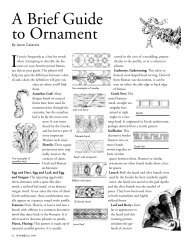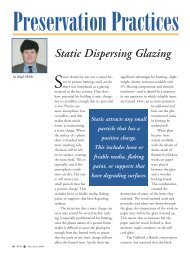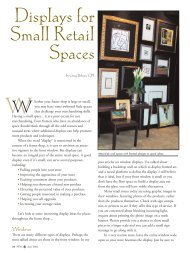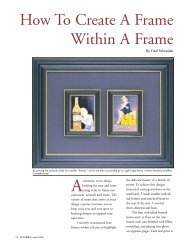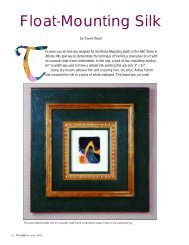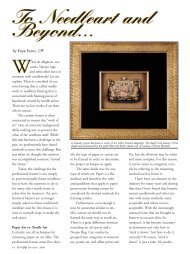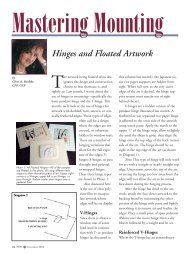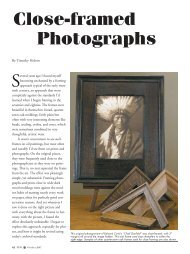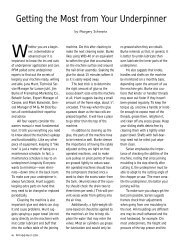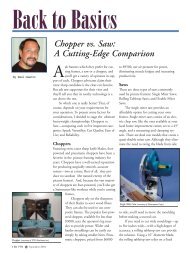TABLE OF CONTENTS - Picture Framing Magazine
TABLE OF CONTENTS - Picture Framing Magazine
TABLE OF CONTENTS - Picture Framing Magazine
Create successful ePaper yourself
Turn your PDF publications into a flip-book with our unique Google optimized e-Paper software.
used and it is fractured at the edge, the<br />
spacer will provide some stabilization of<br />
the shards. In this case, as in the case of<br />
the spacer attached to the frame, the<br />
glazing should first be cleaned. The mat<br />
board and sanded polyester film spacer<br />
can then be attached with double-sided<br />
acrylic tape in a pinwheel pattern and<br />
the excess trimmed off. The spacer can<br />
be reenforced with a strip of tape which<br />
is attached to the portion of the front of<br />
the glazing which will be hidden by the<br />
frame and which is wrapped around to<br />
the side of the spacer. This taping should<br />
be especially strong at the corners to<br />
hold them together. The polyester layer<br />
in the spacer should keep the volatile<br />
portions of this tape away from the inside<br />
of the frame and should extend the life of<br />
its bond.<br />
FRAME SEALING<br />
The mention of tape in connection with a<br />
mat package brings to mind the question<br />
of whether and how the package should<br />
be sealed. There are a number of factors<br />
which must be considered in this context.<br />
What is being sealed in and what is<br />
being sealed out? How long can the seal<br />
be expected to last? How effective will<br />
the seal be under different conditions?<br />
How difficult and expensive will it be to<br />
establish various levels of sealing of the<br />
package? How much benefit can be<br />
expected from a sealed package?<br />
The materials which are to be<br />
sealed in a package with a work of art on<br />
paper should be as well known and,<br />
therefore, as simple as possible. The<br />
fewer the variables that are included, the<br />
fewer chances there are for an unanticipated<br />
problem. If the components have<br />
been proven over long periods of time to<br />
have no adverse effect on delicate art<br />
which has been stored in proximity to<br />
them, they should work well in the<br />
f u t u re. Boards and hinging materials<br />
made of pure cellulose will be chemical-<br />
26 PFM February 1996<br />
ly similar to the paper on which the art<br />
has been done, as will vegetable starch<br />
hinging paste which, like paper, is a<br />
polysaccharide. Synthetic glues have a<br />
less proven track record than animal and<br />
vegetable glues and pastes, but the best<br />
of the synthetics certainly seem to be<br />
stable and relatively inert.<br />
The inclusion of plasticizers and<br />
tackifiers in pre s s u re-sensitive adhesives<br />
raises more questions. These additives<br />
are often not chemically linked to<br />
the material which they are modifying .<br />
A plasticizer, for instance, can keep a<br />
material supple by holding its molecular<br />
structure apart so linkages which would<br />
create more rigidity can not form. This<br />
sort of material may migrate out of the<br />
substance to which it was added. This<br />
could be especially troublesome if it<br />
migrated out into a closed environment.<br />
One question to ask in designing a<br />
package which will house something<br />
valuable and especially a package<br />
which is to be sealed, is: do any of the<br />
materials to be used have an odor? The<br />
human nose may not be as acute as that<br />
of other mammals, but it can detect a<br />
vast array of off-gassing molecules.<br />
Some things like hinging paste may<br />
have a benign odor, but a tape which<br />
smells of vinegar is probably emitting<br />
acetic acid. If the materials to be used<br />
inside the package have been determined<br />
to be stable and inert, the next<br />
question involves the nature of the seal<br />
and what it will exclude.<br />
Different materials can be used to<br />
seal out particulate and gaseous pollution,<br />
humidity, and light. Nothing can<br />
give long term insulation from changes in<br />
t e m p e r a t u re, so the effect of these<br />
changes on the materials and on the<br />
design of the package must be conside<br />
red. No package containing any materials<br />
which are conditioned to higher than<br />
accepted relative humidity conditions<br />
can be safely sealed. Indeed, since pack-<br />
ages which contain glazing will transmit<br />
water vapor through their glazing, having<br />
the materials to be sealed slightly on the<br />
d ry side will permit a greater margin for<br />
s a f e t y. The accepted conditions re f e rre d<br />
to here are fifty percent relative humidity<br />
at seventy degrees fahrenheit or ro u g hly<br />
twenty degrees celsius.<br />
Most art on paper will do well in<br />
somewhat dryer conditions than these,<br />
but extreme drying will cause the paper<br />
to become brittle and will cause paint<br />
films and emulsions to crack. If a package<br />
with damp components is sealed, the<br />
relative humidity can rise as it cools and<br />
c ross the threshold at which fungal<br />
growth can occur (namely, sixty five to<br />
seventy percent). A damp package may<br />
also experience condensation if it is suddenly<br />
illuminated strongly and the paper<br />
products and air within warm up more<br />
rapidly than the glazing.<br />
Excess humidity must never be<br />
sealed in. The only true barrier to<br />
humidity is a metal film. Most coatings<br />
and plastics sheets and boards will permit<br />
the passage of water and other<br />
vapors. The exact rate of this transmission<br />
is too complicated a question to be<br />
factored in to the design of a framing<br />
package, but it can be said that the<br />
thicker the material, the slower and less<br />
efficient its transmission.<br />
While much of the gaseous pollution<br />
which comes from our atmosphere<br />
will be sealed out by a plastic barrier, a<br />
sacrificial metal scavenger or molecular<br />
sieve is needed to give such a layer the<br />
kind of efficacy which approaches that of<br />
a metal foil. Since the metal foil will<br />
stop the passage of water vapor, it can not<br />
be safely used in framing unless the<br />
materials and environment involved in<br />
c o n s t ructing the frame can be guaranteed<br />
to be conditioned in the proper range. If<br />
this can not be provided, the sealing out<br />
of pollution may be effected through the<br />
use of the plastic barrier and may be



